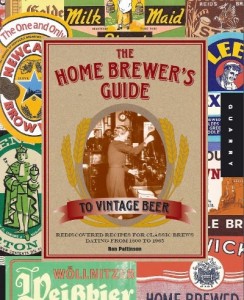A few years back, I went to a Meet the Brewer event at Beer Table featuring Pretty Things, one of my favorite brewers. The special surprise they had for us was the somewhat cryptically titled “November 15th, 1901 KK”, the second brew in their Once Upon A Time series of historical beers. It was black without even the slightest hint of roast character and packed with a ton of English hops, suggesting that the Brits did the whole “Black IPA” thing a century before anyone over on this side of the Atlantic (and did so without throwing such a divisive name on the beer). The story behind the beer, which can be found in more detail at Old Beers, is that Pretty Things collaborated with a part-time British beer historian to brew recipes directly from historical brewing logs. The historian in question is an Englishman dwelling in Amsterdam by the name of Ron Pattinson. He runs a blog called Shut Up About Barclay Perkins, which not only holds a wealth of historical beer information and recipes, it is also an opportunity to see a historian working in real time. Many of the posts feature part or all of an original document coupled with Ron’s explanations and interpretations of that document.
Recently, Ron published The Home Brewer’s Guide to Vintage Beer. The book begins with an overview of historical ingredients and the challenges these create for modern brewers looking to recreate these beers. For example, the specialty brown malt of today is very different than the brown malt that served as a base malt in the 19th century–a major obstacle to anyone wishing to exactly recreate almost any porter (or stout) recipe in the book. Hops present another challenge, as the majority of the recipes predate the quantification of alpha acids in hops and bitterness in beer.
The bulk of this book is a collection of recipes dating from 1800 to 1965 organized more or less by style, with a brief historical exposition presented before each section’s recipes. Regular readers of Pattinson’s blog will be familiar with many of the stories and themes (IPA was not a strong beer, popular accounts of Scottish brewing traditions are nonsense, etc.), but one of the highlights of this books is seeing all of this information collected and edited into a chronological narrative. Yes, some of the details like advertisements and gravity tables are omitted, but those are still available back on the blog. Despite the editing, Pattinson’s personality comes through in the writing, as does his enthusiasm for the subject.
The recipes are scaled to fit the typical 5-gallon homebrew batch, and typically include simplified mash and boil schemes, for those who don’t wish to do, say, two mashes, three sparges, and a four-hour boil. Each recipe has a brief set of notes attached which typically highlight the historical significance of the beer, unusual ingredients, and modern modifications.

An example of the recipe format for the book, with grains, hops, gravity, ABV, IBM, SRM, and mash info.
The recipes are all-grain, which makes the book more appropriate for experienced brewers, and knowing how to adapt recipes to your system is essential. As the title suggests, the book is written primarily for homebrewers, though I imagine anyone interested in the history of British beers can gain something from a read. The recipes tell an interesting story on their own to those who can parse abbreviations such as OG, FG, and IBU, and Pattinson provides a healthy dose of supporting context. For me, one of the highlights of the recipes is to see what a diverse range of beers British brewers were able to produce with a limited range of ingredients – nearly all of the 19th century recipes, outside of porter and stout, are built from pale malt and Goldings hops.
We recently had a party at our apartment where we served beers we made from 1830’s recipes, two of which are in this book. I have another two lined up for brewing in the coming weeks. I recommend this book primarily to anyone looking to brew examples of the ancestors of today’s beers, and secondly to curious folks looking to learn a different side of history. The Home Brewer’s Guide to Vintage Beer is published by Quarry Books and is available in spiral-bound or Kindle editions.

